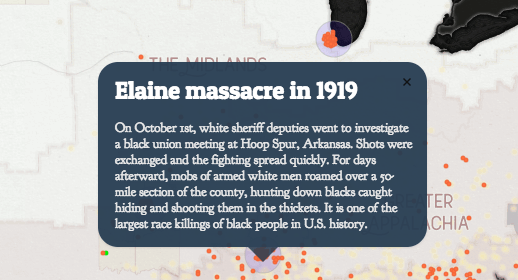For my lesson, I would use the map of mob violence. Students would be instructed to go to the site and use it as a jumping point to research different acts of violence. Students would be separated into small groups, and they would work together to research the violence that occurred in different regions of America. Regions would be separated into the regions this map creates: “Left Coast”, “Far West”, “Yankee North”, “Spanish Heritage El Norte”, “The Midlands”, “Greater Appalachia” and “The Deep South”. Students would use this map as a jumping point to research the mob violence that has occurred in this region over the years, and how it changed over time. For example, the west coast had quite a few Native American victims of mob violence during the early years of this map and eventually has more Chinese victims. Each plot point can be clicked on and the story behind the violence can be expanded (see screenshots below). Many of the plot points link to sources, which would allow students to find more details on the killing, and be able to present a fuller story about why these incidents of mob violence occurred.
Students would research a few of the incidents to find greater detail, and present their findings to the class. We would use their findings to discuss the history of mob violence in our country, as well as draw parallels to issues we see today. This could be used in conjunction with a unit about progressive reforms, civil rights, or something along those lines.




Nice work, Jana! I also used the map of Mob Violence for my lesson. I like your idea of separating students into groups by geographical region. It is interesting to compare how different parts of the country treated racial minorities during differing historical periods. I’m sure your students would find interest in this topic, especially as it relates to modern day – even if they are usually a quiet bunch!
I agree with Nick K. Interesting for students to explore regional “scapegoating”